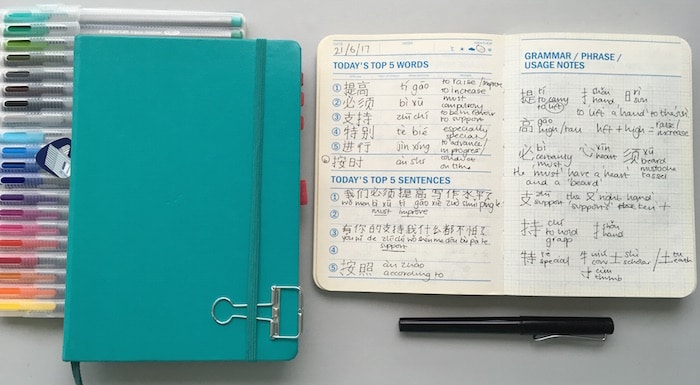It will only take [est_time] to read this post!
I use my bullet journal to track my personal goals, such as exercising more often (obviously), saving money and baking the perfect scones! Although one of my goals is also to pass an HSK exam (Chinese proficiency test), I haven’t figured out how to use my journal to track and study in order to achieve my goal.
After scouring the internet (mostly Pinterest) for ideas on how to use my BuJo to study Chinese, I started to work on this list, in a way to solve my selfish needs, but to also provide fellow bujo-ers with ideas on how to use their bullet journal for learning languages.
Here are 8 (and a half) ways that you can use your journal to learn, review and track the progress of learning a language. I’m focusing mainly on Chinese, since that’s the language I’m studying, but I think many of these methods can be used for studying other languages!
If you’re new to journaling or even learning a language, you might be interested to see what I use to journal.
My normal journal is an ‘emerald’ LEUCHTTURM1917.
I have a DEBON A5 Vocabulary Book Notebook for Students’ Foreign Language Learning for practising characters, writing example sentences and studying radicals.
1. Visualise Vocabulary
Use your bujo to draw pictures of words you want to learn. I used a page in my journal to draw some of the fruit and vegetables I couldn’t remember, along with their names in Chinese.
Obviously, this works best with nouns in categories, like animals, food, places etc, but with written Chinese, you can also use your journal to create visual stories to help you remember characters.
If you don’t feel confident drawing from memory, take a look at some sites that make icons for the web to get some ideas.
2. Track Your Studies
I like to write down the characters that I want to study or the ones I have problems with.
Furthermore, like in the example above, you can breakdown your studying from a book, podcast or TV show so that you’re not studying a massive amount at once. I love how the creator of this bullet journal has split everything into separate sections and divided them into bitesize chunks.
3. Show Word Origin & Etymology
Whenever I come across a character or bigram I don’t know well, I break it down into its different parts to study it in more detail. I actually don’t use my bullet journal for this, I have a separate Chinese writing book, that was made for learning a language.
4. Practise Writing Characters
If you’re studying written Chinese, you might want to check out these printable ‘field’ grid sheets to help you write your Chinese characters correctly. Just print, cut and stick into your BuJo.
If you’re using an official bullet journal or a LEUCHTTURM1917 like me, they already have dots instead of lines. The dots are perfect for practising writing characters as the dots work as guidelines, similarly to the ‘field’ grids.
Don’t forget to learn the correct strokes by following the stroke order on our Online Dictionary!
5. Write your Bujo in another language
I found this idea posted in a Facebook group and I think writing your BuJo in Chinese (or any language) is a great way to remember specific characters. You can use this in each part of your journal, not just the index. For example if you have a layout for daily habits and routine, you’ll see the same characters repeated each day.
6. Decorate Your Bujo
If you don’t want to write you whole journal in another language, just use the language to ‘decorate’ your journal. With the Chinese language, you can try out some Chinese calligraphy in your bullet journal.
I also want to add that Chamcen, my Chinese colleague, made the above example for me using her calligraphy brush. If you’re interested in learning the basics of learning Chinese calligraphy, take a look at Nora’s article, Learning Chinese Calligraphy.
There are also books that teach Chinese calligraphy, including Chinese Calligraphy Made Easy: A Structured Course in Creating Beautiful Brush Lettering.
7. Set Language Challenges
As I previously mentioned, I use my journal for goal setting and tracking various habits. In order to achieve my goals, I break everything down in order into smaller more achievable chunks.
To achieve my larger goal of taking an HSK exam, I can set daily/weekly/monthly challenges. For example to study X amount of words, read 2 Chinese stories, watch 4 episodes of a Chinese TV show, 2 Chinese movies etc.
8. Make DIY ‘Flashcards’
Use tab page markers to write the Chinese characters (or any language you’re learning) and then write the English translation underneath. You can mix it up and have your native language on the tab and the Characters underneath or Pinyin on the top with characters or English inside, depending on your level or needs.
BONUS: TRAVEL JOURNAL
This last one isn’t for language learning per say, but it’s fun to have if you’re travelling around a new country. You can get an outline of the map of China and write the cities names in the local language or draw pictures of the places you’ve visited. You can get some more ideas for your travel journal here.
If you have other ways that you can use a journal to learn a language, please share them with us below!
